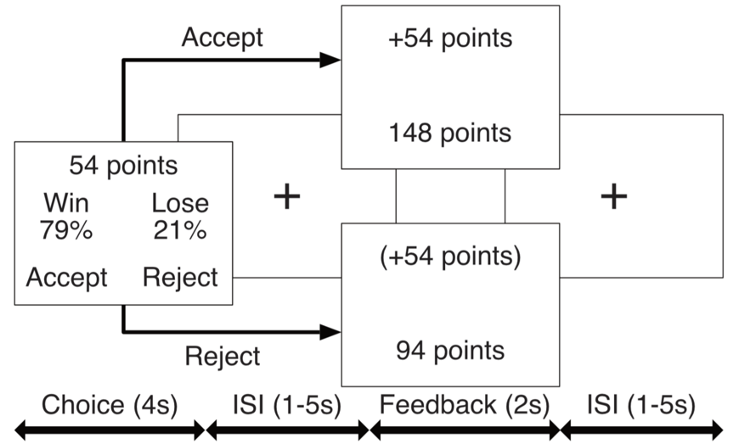Experiments
To validate ideas and models, our lab conducts empirical studies that apply psychological experimental designs with neurophysiological measurements to empirically evaluate the idea or provide proof-of-concept that the brain is a physical system that implements predictive coding.
Value-based decision processing in the brain
This was the starting topic for our lab in 2012. Many studies have conducted important work on how the brain computes rewards and values when making decisions about choices. However, these studies focused on the brain’s method of representing value from the perspective of a universal and stable operation. As such, we wanted to know how age-related effects on brain functioning alter the way the brain represents value. We applied a series of studies involving Lottery Choice Task fMRI experiments to evaluate younger and older brains as they deliberated stimuli value.

Our published results showed that there is a drastic age-related shift in brain regions centrally involved in processing stimuli value information from striatal nuclei in younger adults to medial temporal, medial prefrontal, and lateral prefrontal cortices in older adults [1]. This spatial shift in brain areas was also associated with a temporal processing shift. Younger adult brains have sensitivity to value information in earlier processing stages (about 200 ms post-stimulus) whereas older adult brains processed value only in later stages (about >300 ms post-stimulus) [2]. Finally, we also found a notable range of individual differences across a large sample of older adult brain responses to value in the above-implicated brain regions [3], in comparison to a much narrower range of decision behaviors usually observed in younger adults.
Integrating these findings, we speculate that the younger brain is more sensitive to objective environmental information and contains less subjective alternative beliefs about the environment. By contrast, age-related effects on the brain might elevate biases to interpret external information with a greater range of subjective beliefs about its causes. [4][5]
Neural representations of cognitive maps about the environment
Using our theoretical models and based on our previous findings on decision-making, we are now currently working on finding out how subjective biases in the interpretation of environmental information arise. We theorize that our brain is a system that can only observe how objects in the environment interact with each other, including our own interactions with these objects. Through variations in the resulting information states that we sense, our brain forms cognitive maps to summarily represent the states of the environment, which is its causal graph or belief. The brain’s belief then drives its predictions about the next environmental states and the appropriate actions it should select, correspondingly.
We are now conducting several ongoing experiments evaluating the above neuropsychological mechanisms. These include fMRI or EEG tasks that probe spatial navigation, temporal processing, conceptual belief updating, language processing, and information equilibrium, in younger and older adults.
Lego Robot Programming intervention for older adult inference processing
If predictive or inferential processing is fundamental to neural computation and organization, then engaging in inferential processing might proliferate neural circuitry. We are now in the midst of running a randomized clinical trial cognitive intervention to modulate older adult inference processing (NCT05341232). Participants in this clinical trial undergo a 12-week Lego Robot Programming training course held at the National Taiwan Science Education Center. Participants also undergo pre- and post-training comprehensive assessment of neurocognitive abilities, as well as brain MRI, and EEG measurement of neurophysiological functions. This clinical trial is expected to complete in 2024.
Bibliography
- Su, Y.-S., Chen, J.-T., Tang, Y.-J., Yuan, S.-Y., McCarrey, A. C., & Goh, J. O. S. (2018). Age-related differences in striatal, medial temporal, and frontal involvement during value-based decision processing. Neurobiology of Aging, 69, 185–198. https://doi.org/10.1016/j.neurobiolaging.2018.05.019 [url]
- Chen, P., Hung, H.-Y., & Goh, J. O. S. (2023). Age-related differences in ERP correlates of value-based decision making. Neurobiology of Aging, 123, 10–22. https://doi.org/10.1016/j.neurobiolaging.2022.11.008 [url]
- Goh, J. O. S., Su, Y.-S., Tang, Y.-J., McCarrey, A. C., Tereshchenko, A., Elkins, W., & Resnick, S. M. (2016). Frontal, Striatal, and Medial Temporal Sensitivity to Value Distinguishes Risk-Taking from Risk-Aversive Older Adults during Decision Making. The Journal of Neuroscience, 36(49), 12498–12509. https://doi.org/10.1523/JNEUROSCI.1386-16.2016 [url]
- Su, Y.-S., & Goh, J. O. S. (2020). Cognitive Aging and Culture: Older Brain Predictions about Different Environments. In A. K. Thomas & A. Gutchess (Eds.), The Cambridge Handbook of Cognitive Aging: A Life Course Perspective (pp. 457–479). Cambridge University Press. https://doi.org/10.1017/9781108552684.029 [url]
- Chen, C.-C., Su, Y.-S., Tu, Y.-Z., & Goh, J. O. S. (2019). Default-mode network activation underlies accurate contextual processing of exclusive disjunctions in older but not younger adults. Neuroimage, 201, 116012. https://doi.org/10.1016/j.neuroimage.2019.116012 [url]
